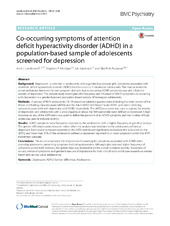Co-occurring symptoms of attention deficit hyperactivity disorder (ADHD) in a population-based sample of adolescents screened for depression
Peer reviewed, Journal article
Published version
Permanent lenke
https://hdl.handle.net/1956/12525Utgivelsesdato
2016-02-25Metadata
Vis full innførselSamlinger
Originalversjon
https://doi.org/10.1186/s12888-016-0739-3Sammendrag
Background: Depression is common in adolescents, with a gender bias towards girls. Symptoms associated with attention deficit hyperactivity disorder (ADHD) tend to co-occur in depressed adolescents. This may be related to common features between the two symptom domains, but co-occurring ADHD symptoms may also inflate the severity of depression. The present study investigates the frequency and influence of ADHD symptoms co-occurring with depression in a gender balanced population-based sample of Norwegian adolescents. Methods: A sample of 9614 adolescents (16–19 years) completed a questionnaire including the short version of the Mood and Feelings Questionnaire (sMFQ) and the Adult ADHD Self-Report Scale (ASRS), with items reflecting symptoms associated with depression and ADHD, respectively. The sMFQ sum score was used as a proxy for severity of depression, and adolescents with a score equal to or above the 90th percentile were defined as depressed. A high response on any of the ASRS items was used to define the presence of an ADHD symptom, and the number of high scores was used to indicate severity. Results: ADHD symptoms were frequently reported by the adolescents, with a higher frequency in girls than in boys. The gender differences were, however, minor when the analysis was restricted to the adolescents defined as depressed. Each severe symptom reported on the ASRS contributed significantly to increase the sum score on the sMFQ, and more than 20% of the adolescents defined as depressed reported six or more symptoms within the ASRS inattention subscale. Conclusions: The results emphasize the importance of screening for symptoms associated with ADHD when assessing adolescents presenting symptoms indicating depression. Although girls reported higher frequency of symptoms within both domains, the gender bias was dependent on the overall symptom severity. Awareness of co-occurrence of symptoms and gender biases are of importance for both clinical work and future research on mental health and service use in adolescence.

